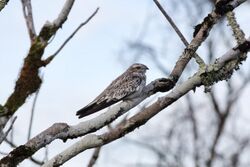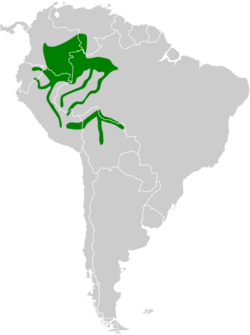Sand-coloured nighthawk
Topic: Biology
 From HandWiki - Reading time: 3 min
From HandWiki - Reading time: 3 min
| Sand-coloured nighthawk | |
|---|---|

| |
| In Ucayali Region, Peru | |
| Scientific classification | |
| Domain: | Eukaryota |
| Kingdom: | Animalia |
| Phylum: | Chordata |
| Class: | Aves |
| Clade: | Strisores |
| Order: | Caprimulgiformes |
| Family: | Caprimulgidae |
| Genus: | Chordeiles |
| Species: | C. rupestris
|
| Binomial name | |
| Chordeiles rupestris (Spix, 1825)
| |

| |
The sand-colored nighthawk (Chordeiles rupestris) is a species of nightjar in the family Caprimulgidae. It is found in Bolivia, Brazil , Colombia, Ecuador, Peru, and Venezuela.[1][2]
Taxonomy and systematics
Major taxonomic systems recognize two subspecies of sand-colored nighthawk, the nominate Chordeiles rupestris rupestris and C. r. xylostictus.[1][3][4] However, at least two authors contend it is better treated as monotypic.[5][6]
Description
The sand-colored nighthawk is 20.5 to 22 cm (8.1 to 8.7 in) long. Its upperparts are pale grayish brown with darker brown streaks, bars, and spots. The chin and throat are white to buffy white, the breast grayish white with a cinnamon tinge and brown bars and spots, and the belly white with brown spots on its upper part. The underside of the wing is also mostly white.[7]
Distribution and habitat
The nominate subspecies of sand-colored nighthawk is found widely in northwestern Amazonia of southeastern Colombia, southwestern Venezuela, northeastern Peru, and northwestern Brazil. It is also found more narrowly along river corridors in eastern Ecuador, Peru, northern Bolivia, and western Brazil. C. r. xylostictus is found only in Colombia's Cundinamarca Department. The species inhabits the western Amazon basin, primarily along watercourses but including oxbow lakes and grassy clearings such as airstrips. It is seldom found in areas above 500 m (1,600 ft) elevation.[7]
Behavior
The sand-colored nighthawk is crepuscular and nocturnal. During the day it roosts on river islands and sandbars, often in large numbers. In times of high water it will roost in trees overhanging the water.[7]
Feeding
The sand-colored nighthawk forages very actively at dusk and then on and off during the night. Its diet has not been studied in detail but is known to be entirely insects. Its flight has been described as less erratic than that of other nightjars, with an "oddly mechanical"" flapping that resembles that of terns.[7]
Breeding
The sand-colored nighhawk's breeding season spans from May through August in southeastern Peru and from June to September in central Brazil but has not been defined in the rest of its range. They nest in loose colonies, often near those of yellow-billed tern, large-billed tern, and black skimmer. They lay their clutch of two eggs in a scrape on a sandbar.[7]
Vocalization
The sand-colored nighthawk apparently seldom sings, but it does so from the ground, "a gurgling purr...interspersed with quiet throat-clearing sound and loud grawh notes." It also makes a variety of other vocalizations when chasing another bird or defending a nest.[7]
Status
The IUCN has assessed the sand-colored nighthawk as being of Least Concern. It has a very large range, and though its population is believed to be declining, the rate of decline is not thought to be fast enough for a more serious rating. No immediate threats have been identified.[8]
References
- ↑ 1.0 1.1 Gill, F.; Donsker, D.; Rasmussen, P. (July 2021). "IOC World Bird List (v 11.2)". https://www.worldbirdnames.org/.
- ↑ Remsen, J. V., Jr., J. I. Areta, E. Bonaccorso, S. Claramunt, A. Jaramillo, D. F. Lane, J. F. Pacheco, M. B. Robbins, F. G. Stiles, and K. J. Zimmer. Version 24 August 2021. Species Lists of Birds for South American Countries and Territories. https://www.museum.lsu.edu/~Remsen/SACCCountryLists.htm retrieved August 24, 2021
- ↑ Clements, J. F., T. S. Schulenberg, M. J. Iliff, S. M. Billerman, T. A. Fredericks, J. A. Gerbracht, D. Lepage, B. L. Sullivan, and C. L. Wood. 2021. The eBird/Clements checklist of Birds of the World: v2021. Downloaded from https://www.birds.cornell.edu/clementschecklist/download/ Retrieved August 25, 2021
- ↑ HBW and BirdLife International (2020) Handbook of the Birds of the World and BirdLife International digital checklist of the birds of the world Version 5. Available at: http://datazone.birdlife.org/userfiles/file/Species/Taxonomy/HBW-BirdLife_Checklist_v5_Dec20.zip [.xls zipped 1 MB] retrieved May 27, 2021
- ↑ Holyoak, D.T. (2001). Nightjars and their allies: the Caprimulgiformes. Oxford: Oxford University Press. ISBN 978-0198549871.
- ↑ Cleere, Nigel (2010). Nightjars, Potoos, Frogmouths, Oilbird and Owlet-nightjars of the World. Old Basing, UK: WildGuides. ISBN 978-0691148571.
- ↑ 7.0 7.1 7.2 7.3 7.4 7.5 Whyland, N. (2020). Sand-colored Nighthawk (Chordeiles rupestris), version 1.0. In Birds of the World (T. S. Schulenberg, Editor). Cornell Lab of Ornithology, Ithaca, NY, USA. https://doi.org/10.2173/bow.sacnig1.01 retrieved October 4, 2021
- ↑ Cite error: Invalid
<ref>tag; no text was provided for refs namedIUCN
Wikidata ☰ Q29249 entry
 |
 KSF
KSF
